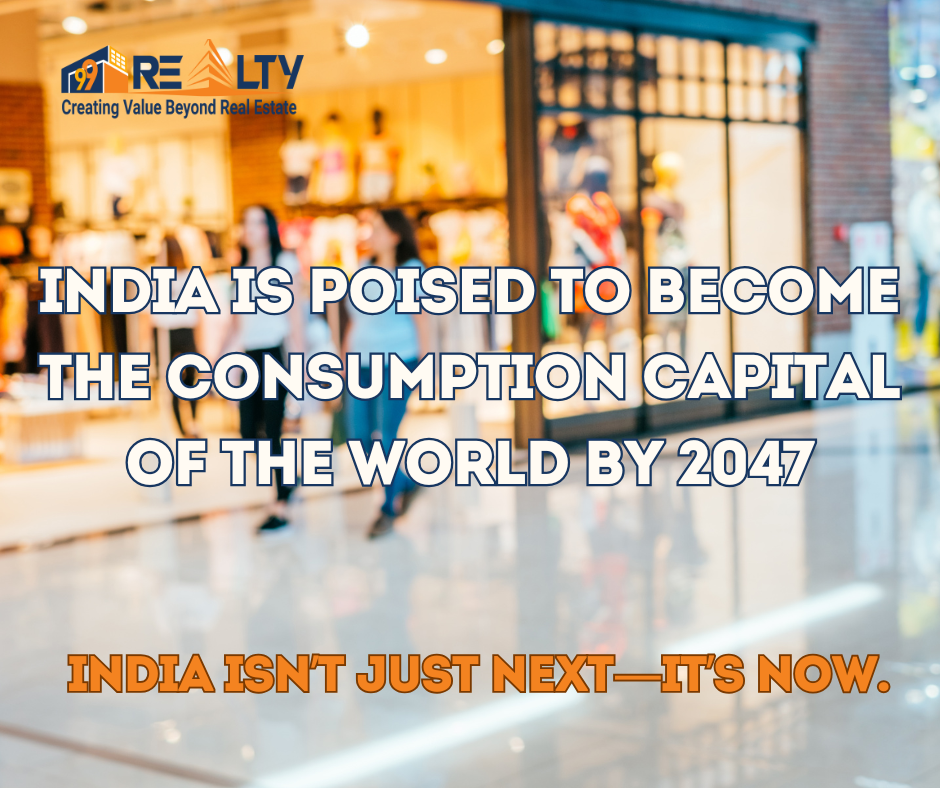India is on the cusp of a profound economic transformation. As the nation accelerates towards becoming the consumption capital of the world, a seismic shift is underway—driven by expanding household incomes, a burgeoning Gen Z population, robust savings growth, and the rapid rise of discretionary spending. We explore the core economic forces positioning India as the epicenter of global consumer demand in the coming decades.
🚀 India’s Consumption Engine: The Fastest Growing GDP Component
Consumption currently contributes 56% to India’s GDP, representing the largest and most dynamic segment of the national economy. Fueled by tax reforms, urbanization, and the demographic dividend, consumption is forecast to double by 2034, placing India firmly ahead of major global economies.
- Current Private Final Consumption Expenditure (PFCE): ~$2 trillion
- Projected PFCE by 2034: ~$4 trillion+
- Annual Consumption Growth Rate: ~9–10%
This momentum is powered not just by volume, but by quality—Indians are shifting from subsistence to aspirational spending patterns across all income tiers.
💸 Household Savings to Hit $103 Trillion by 2047: A Consumption Catalyst
Between FY1997 and FY2023, India accumulated $12 trillion in household savings. In the next 25 years, this figure is set to surge 10-fold, reaching $103 trillion by 2047.
Impact on Consumption:
- Enhanced financial security leads to increased risk-taking and higher discretionary spending.
- Wealth effect from savings accumulation boosts consumption of high-ticket items (real estate, automobiles, travel, etc.).
- Greater investment in insurance, mutual funds, and retirement instruments, unlocking cyclical liquidity into the economy.
$103 Trillion in Household Savings by 2047
🧾 Union Budget Tax Cuts: Unlocking ₹3.3 Lakh Crore in Consumption
The recent tax cuts announced in the Union Budget are projected to release ₹1 lakh crore into the hands of consumers. This could directly translate into an incremental consumption surge of ₹3.3 lakh crore, contributing 1% growth in GDP.
Key Spending Sectors Expected to Benefit:
- Consumer Electronics (smartphones, home appliances, wearables)
- Fashion and Apparel
- Automobiles
- Experiential Categories (travel, dining, entertainment)
The latest tax reforms will inject ₹1 lakh crore into consumers’ hands, triggering a ₹3.3 lakh crore consumption surge.
🧑💼 Demographics as Destiny: India’s Youth Power
India houses more Gen Z individuals than the entire population of the United States. By 2035, one in every two rupees spent will be driven by Gen Z consumers—digital natives with strong brand consciousness, high engagement with tech, and preference for experiences over possessions.
Gen Z Will Drive 50% of All Spending by 2035
Consumption Trends Among Gen Z:
- High adoption of digital wallets, BNPL (Buy Now Pay Later), and embedded finance.
- Demand for premium goods, sustainability, and hyper-personalized services.
- Willingness to spend on mental wellness, niche hobbies, creator economy, and immersive tech.
🏠 Household Growth Outpacing Population: The Nuclear Family Surge
The structural transformation in household formation, where household growth is outpacing population growth, is creating a multiplier effect on consumption:
Household Growth > Population Growth
- Rise in dual-income nuclear families.
- Greater need for individual household goods and services (appliances, furnishings, utilities).
- Increased per-household discretionary spending.
🛍️ Discretionary Spending to Eclipse Essentials
Mirroring the consumption boom seen in China and the US during their per capita income expansions, India is expected to follow suit.
Historic Pattern (China & US):
- Non-essential spending soared 10x during income surges.
- Shift from food and utilities to leisure, travel, and luxury goods.
India’s Mirror Projection:
- Per capita income expected to cross $5,000 by 2034.
- Discretionary spending categories to lead:
- Consumer Electronics
- Jewellery and Accessories
- Home Décor and Furnishing
- Health and Wellness
- Education and EdTech
🏬 Kirana Dominance and the Rise of Modern Retail
Despite a growing modern retail sector, 92% of India’s retail still flows through traditional Kirana stores. This presents a massive scalability opportunity for organized retail and e-commerce players.
Modern Retail Opportunities:
- Digitization of Kirana via POS, UPI, and e-inventory management.
- Expansion of D2C (Direct-to-Consumer) brands tapping Tier 2 & 3 cities.
- Omnichannel retail adoption bridging physical and digital storefronts.
India Has 92% Retail Still in Kirana Format
🔋 Workforce Growth: The World’s Labor Capital
India will lead global workforce growth through 2047, with 20% of the world’s working-age population residing in the country. This demographic dividend supports a perpetual rise in income, demand, and consumption.
Key Workforce-Driven Trends:
- Urban migration and salaried job expansion.
- Middle-class expansion to 700 million by 2030.
- Increased consumption of personal transport, real estate, and white goods.
The world’s youngest labor force = the world’s biggest spenders.
🌍 India’s Ascent: Positioned as the Global Consumption Epicenter
With favorable macroeconomic reforms, digital transformation, and a thriving entrepreneurial ecosystem, India is uniquely placed to surpass traditional consumption leaders by 2040.
Comparative Outlook:
| Metric | India (2034 Projection) | China | USA |
|---|---|---|---|
| Consumption as % of GDP | 65% | 55% | 67% |
| Gen Z Population | 370M | 250M | 68M |
| Middle-Class Households | 500M+ | 400M | 150M |
| E-commerce Market Value | $200B+ | $2T | $1.5T |
🧠 Strategic Implications for Businesses and Investors
- FMCG and D2C brands must localize offerings, pricing, and experiences tailored to aspirational consumers in semi-urban zones.
- Retail tech platforms have an untapped market in Kirana modernization and last-mile logistics.
- Investors should look to sectors such as consumer durables, fashion, fintech, and food services to leverage the consumption wave.
India isn’t just next—it’s now.
🏁 Conclusion
India is not just witnessing a consumption boom—it is scripting a long-term economic reorientation that positions it as the undisputed consumption capital of the world. The convergence of demographic advantages, household dynamics, tax reforms, and financial maturity ensures that this transformation is not a passing phase but a generational inflection point.
For businesses, investors, and global market observers, the message is clear: India is not just the next big consumer story—it is the defining one.
Subscribe to get updates on our latest posts and market trends.






Join The Discussion